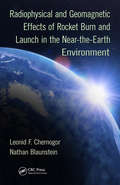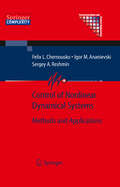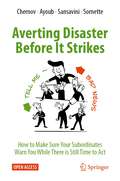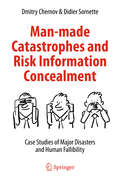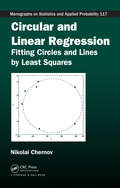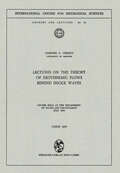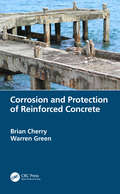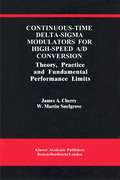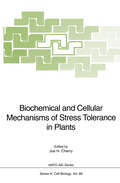- Table View
- List View
Complex Networks and Their Applications XI: Proceedings of The Eleventh International Conference on Complex Networks and Their Applications: COMPLEX NETWORKS 2022 — Volume 1 (Studies in Computational Intelligence #1077)
by Hocine Cherifi Rosario Nunzio Mantegna Luis M. Rocha Chantal Cherifi Salvatore MiccichèThis book highlights cutting-edge research in the field of network science, offering scientists, researchers, students, and practitioners a unique update on the latest advances in theory and a multitude of applications. It presents the peer-reviewed proceedings of the XI International Conference on Complex Networks and their Applications (COMPLEX NETWORKS 2022). The carefully selected papers cover a wide range of theoretical topics such as network models and measures; community structure, network dynamics; diffusion, epidemics, and spreading processes; resilience and control as well as all the main network applications, including social and political networks; networks in finance and economics; biological and neuroscience networks and technological networks.
Complex Networks & Their Applications XII: Proceedings of The Twelfth International Conference on Complex Networks and their Applications: COMPLEX NETWORKS 2023, Volume 3 (Studies in Computational Intelligence #1143)
by Hocine Cherifi Luis M. Rocha Chantal Cherifi Murat DonduranThis book highlights cutting-edge research in the field of network science, offering scientists, researchers, students and practitioners a unique update on the latest advances in theory and a multitude of applications. It presents the peer-reviewed proceedings of the XII International Conference on Complex Networks and their Applications (COMPLEX NETWORKS 2023). The carefully selected papers cover a wide range of theoretical topics such as network embedding and network geometry; community structure, network dynamics; diffusion, epidemics and spreading processes; machine learning and graph neural networks as well as all the main network applications, including social and political networks; networks in finance and economics; biological networks and technological networks.
Complex Networks & Their Applications XII: Proceedings of The Twelfth International Conference on Complex Networks and their Applications: COMPLEX NETWORKS 2023 Volume 1 (Studies in Computational Intelligence #1141)
by Hocine Cherifi Luis M. Rocha Chantal Cherifi Murat DonduranThis book highlights cutting-edge research in the field of network science, offering scientists, researchers, students and practitioners a unique update on the latest advances in theory and a multitude of applications. It presents the peer-reviewed proceedings of the XII International Conference on Complex Networks and their Applications (COMPLEX NETWORKS 2023). The carefully selected papers cover a wide range of theoretical topics such as network embedding and network geometry; community structure, network dynamics; diffusion, epidemics and spreading processes; machine learning and graph neural networks as well as all the main network applications, including social and political networks; networks in finance and economics; biological networks and technological networks.
Chern on Dispute Boards: Practice And Procedure (Construction Practice Ser.)
by Cyril ChernA dispute board is a panel of impartial members, appointed at the outset of the construction contract, whose purpose is to monitor progress, resolve disputes as they arise and provide a forum for discussing difficult matters. This book provides an in depth analysis of dispute board law and detailed, practical explanations of how dispute boards work in construction contracts for those actively involved. as well as for those who need to learn the process. Important features of the book include: Explanation of how a dispute board works: Insider knowledge of board operations: Key documents to run a dispute board: Detailed discussion of dispute board law (covering key jurisdictions worldwide): Forms of practice and procedure, and sample documents Reviews of the previous edition "Chern's book provides an extremely practical guide, covering not only an introduction to the process but also providing check lists and sample documentation.... This book will be welcome by practitioners in the area and newcomers to the dispute board process." —The International Journal of Arbitration, Mediation and Dispute Management, November 2009 "This book will provide a very useful, perhaps essential, guide to parties commissioning large capital construction projects, those advising them and those bidding to carry out such works, and importantly, the project funders." —The Expert & Dispute Resolver "This is a must-have book for grown up contractors" —Tony Bingham, Building "His timely work …concentrating on what may prove to be the primary means of dispute resolution for major international construction projects is to be welcomed." —HHJ Humphrey Lloyd, QC, The International Construction Law Review "This excellent book on Dispute Boards is a must for every construction lawyer, engineer, architect and contractor who is either involved in Dispute Boards or wants to be" —Herbert Wilson, The Journal of the Dispute Board Federation
Chern on Dispute Boards
by Cyril ChernA dispute board is a panel of impartial members, appointed at the outset of the construction contract, whose purpose is to monitor progress, resolve disputes as they arise and provide a forum for discussing difficult matters. This book provides an in depth analysis of dispute board law and detailed, practical explanations of how dispute boards work in construction contracts for those actively involved. as well as for those who need to learn the process. Important features of the book include: Explanation of how a dispute board works: Insider knowledge of board operations: Key documents to run a dispute board: Detailed discussion of dispute board law (covering key jurisdictions worldwide): Forms of practice and procedure, and sample documents Reviews of the previous edition "Chern's book provides an extremely practical guide, covering not only an introduction to the process but also providing check lists and sample documentation.... This book will be welcome by practitioners in the area and newcomers to the dispute board process." —The International Journal of Arbitration, Mediation and Dispute Management, November 2009 "This book will provide a very useful, perhaps essential, guide to parties commissioning large capital construction projects, those advising them and those bidding to carry out such works, and importantly, the project funders." —The Expert & Dispute Resolver "This is a must-have book for grown up contractors" —Tony Bingham, Building "His timely work …concentrating on what may prove to be the primary means of dispute resolution for major international construction projects is to be welcomed." —HHJ Humphrey Lloyd, QC, The International Construction Law Review "This excellent book on Dispute Boards is a must for every construction lawyer, engineer, architect and contractor who is either involved in Dispute Boards or wants to be" —Herbert Wilson, The Journal of the Dispute Board Federation
Chern on Dispute Boards: Practice and Procedure
by Cyril ChernDispute boards were first introduced almost 20 years ago. Since then close to $100 billion US dollars worldwide has been spent on construction projects that have used dispute boards. Of these, 98% were constructed without any court battles and of the remaining 2%, the dispute board decisions were upheld by either arbitration and/or the court: a truly impressive record. Yet very little is known about what dispute boards are and how they operate. This book provides the knowledge necessary for those actively involved in dispute board work as well as for those who need to learn the process. Important features of the book include: analysis of the differences between dispute adjudication boards, dispute resolution boards and combined dispute boards in-depth discussion of both the existing and historical international case law on dispute boards, including its history under the British common law, European civil law and Muslim Sharī’ah law analysis of the differences between the various major standard forms of dispute board rules – FIDIC, International Chamber of Commerce and DBFederation - along with sample wording to add to or modify these forms as needed. analysis of how referrals are made to dispute boards and sample forms. an in-depth discussion of the ethical requirements relating to dispute board members comparison of board selection techniques with guidelines for implementation and recommendations for the parties sample forms for use in establishing a dispute board discussion of site visits, how they should be conducted and sample forms general forms for use in operating a dispute board, form agendas, form reports and their use how to use a dispute board as a sounding board for grievances in depth discussion of how to write a decision or recommendation with examples of actual dispute board decisions and recommendations disclosure forms, questionnaires for potential board members, and comparison of board member agreements and sample forms a discussion of how to effectively use witnesses and the preparation and presentation of witness statements in dispute board hearings forms of notice and procedural rules governing the operation of dispute boards international case studies with claims, responses and decisions analysis of situations requiring the removal of dispute board members and form agreements for their removal discussion of the use of dispute boards in areas other than construction.
Bistatic Radar: Emerging Technology
by Mikhail CherniakovThe impact of bistatic radar technology on remote sensing is increasing as bistatic systems cross the theoretical threshold into practical embodiment. The wide spectrum of radar applications, including space exploration, defence, transport, aerospace, and meteorology, provides persistent impetus for this progress. This book is dedicated to the more advanced studies in bistatic radar which are currently the subject of intensive research activity and development. With contributions from the leading experts in the field of bistatic radar research, this book collates the latest developments in the field focusing particularly on bistatic synthetic aperture radar (BSAR) and passive bistatic radar systems (PBRS). Within these two areas the text: addresses the main BSAR topologies: spaceborne BSAR, airborne BSAR and space-surface BSAR; analyses the resurgent interest in, and practical applications of, PBRS; introduces passive BSAR technology; covers research of systems used in aircraft detection and tracking, and passive radar remote sensing of the ionosphere and the upper atmosphere. Bistatic Radar: Emerging Technology is an invaluable resource for practising engineers and researchers involved in the design and implementation of advanced bistatic radar systems in aerospace, communications, defence, transport and meteorology. Following on from Bistatic Radar: Principles and Practice it is also a comprehensive reference on the latest research for postgraduate students taking specialist courses in radar technology.
Radiophysical and Geomagnetic Effects of Rocket Burn and Launch in the Near-the-Earth Environment
by Leonid F. Chernogor Nathan BlaunsteinRadiophysical and Geomagnetic Effects of Rocket Burn and Launch in the Near-the-Earth Environment describes experimental and theoretical studies on the effects of rocket burns and launchings on the near-the-Earth environment and geomagnetic fields. It illuminates the main geophysical and radiophysical effects on the ionosphere and magnetosphere sur
Evolution of Motions of a Rigid Body About its Center of Mass
by Felix L. Chernousko Leonid D. Akulenko Dmytro D. LeshchenkoThe book presents a unified and well-developed approach to the dynamics of angular motions of rigid bodies subjected to perturbation torques of different physical nature. It contains both the basic foundations of the rigid body dynamics and of the asymptotic method of averaging. The rigorous approach based on the averaging procedure is applicable to bodies with arbitrary ellipsoids of inertia. Action of various perturbation torques, both external (gravitational, aerodynamical, solar pressure) and internal (due to viscous fluid in tanks, elastic and visco-elastic properties of a body) is considered in detail. The book can be used by researchers, engineers and students working in attitude dynamics of spacecraft.
Control of Nonlinear Dynamical Systems: Methods and Applications (Communications and Control Engineering)
by Felix L. Chernous'ko I. M. Ananievski S. A. ReshminThis book is devoted to new methods of control for complex dynamical systems and deals with nonlinear control systems having several degrees of freedom, subjected to unknown disturbances, and containing uncertain parameters. Various constraints are imposed on control inputs and state variables or their combinations. The book contains an introduction to the theory of optimal control and the theory of stability of motion, and also a description of some known methods based on these theories. Major attention is given to new methods of control developed by the authors over the last 15 years. Mechanical and electromechanical systems described by nonlinear Lagrange’s equations are considered. General methods are proposed for an effective construction of the required control, often in an explicit form. The book contains various techniques including the decomposition of nonlinear control systems with many degrees of freedom, piecewise linear feedback control based on Lyapunov’s functions, methods which elaborate and extend the approaches of the conventional control theory, optimal control, differential games, and the theory of stability. The distinctive feature of the methods developed in the book is that the c- trols obtained satisfy the imposed constraints and steer the dynamical system to a prescribed terminal state in ?nite time. Explicit upper estimates for the time of the process are given. In all cases, the control algorithms and the estimates obtained are strictly proven.
Modern Crystallography III: Crystal Growth (Springer Series in Solid-State Sciences #36)
by A.A. ChernovEarly in this century, the newly discovered x-ray diffraction by crystals made a complete change in crystallography and in the whole science of the atomic structure of matter, thus giving a new impetus to the development of solid-state physics. Crystallographic methods, pri marily x-ray diffraction analysis, penetrated into materials sciences, mol ecular physics, and chemistry, and also into many other branches of science. Later, electron and neutron diffraction structure analyses be came important since they not only complement x-ray data, but also supply new information on the atomic and the real structure of crystals. Electron microscopy and other modern methods of investigating mat ter-optical, electronic paramagnetic, nuclear magnetic, and other res onance techniques-yield a large amount of information on the atomic, electronic, and real crystal structures. Crystal physics has also undergone vigorous development. Many re markable phenomena have been discovered in crystals and then found various practical applications. Other important factors promoting the development of crystallog raphy were the elaboration of the theory of crystal growth (which brought crystallography closer to thermodynamics and physical chem istry) and the development of the various methods of growing synthetic crystals dictated by practical needs. Man-made crystals became increas ingly important for physical investigations, and they rapidly invaded technology. The production . of synthetic crystals made a tremendous impact on the traditional branches: the mechanical treatment of mate rials, precision instrument making, and the jewelry industry.
Averting Disaster Before It Strikes: How to Make Sure Your Subordinates Warn You While There is Still Time to Act
by Dmitry Chernov Ali Ayoub Giovanni Sansavini Didier SornetteSome of the major industrial disasters could have been prevented. When the facts of what happened are established, their stories share a common thread: before things spiralled out of control, there were workers at the affected sites who knew that the situation was dangerous, and could become catastrophic unless immediate action was taken. But tragically, nobody dared to tell the decision-makers who could have authorized that action. With no idea of the risks they were taking, the people in charge continued as normal… and disaster struck. Because vital information about risks could not flow freely from the shop floor to the director’s office, the crucial decisions were not made in time. This observation has been documented in the following major technological accidents: Challenger space shuttle explosion (USA, 1986); Chernobyl nuclear plant disaster (USSR, 1986); Deepwater Horizon oil spill (USA, 2010); Fukushima-1 nuclear power plant disaster (Japan, 2011); and numerous other industrial disasters. After accidents like these, losses and costs for dealing with the consequences are often hundreds — or even thousands — of times greater than the finances that would have been required to deal with the risks when they were first recognized.This handbook is about how to transform the way large critical infrastructure companies communicate about safety and technological risks. It aims to support senior managers to get the information they need from their subordinates concerning the risks they are facing, in order to prevent accidents before it is too late.The recommendations in this handbook are based on interviews with 100 executives at various levels, working in 65 critical infrastructure companies around the world, in power, oil and gas, metals, chemicals and petrochemicals, mining and other industries.The recommendations of these leaders were also tested in the pilot project, in an industrial company which is the world leader in its sector. More than 400 managers at various levels of the corporate hierarchy, and employees at several of the company’s industrial plants, took part in the project.This open access handbook is written for the owners, senior managers, and industrial safety directors of critical infrastructure companies.
Man-made Catastrophes and Risk Information Concealment: Case Studies of Major Disasters and Human Fallibility
by Dmitry Chernov Didier SornetteThis book discusses the risks of information concealment in the context of major natural or industrial disasters – offering detailed descriptions and analyses of some 25 historical cases (Three Mile Island nuclear accident, Bhopal disaster, Challenger Space Shuttle explosion, Chernobyl nuclear disaster, Deepwater Horizon oil spill, Fukushima-Daiichi nuclear disaster, Enron’s bankruptcy, Subprime mortgage crisis, Worldwide Spanish flu and SARS outbreaks, etc.) and applying these insights to selected on-going cases where such information concealment is suspected. Some successful examples of preventive anti-concealment practice are also presented.In the book, the term ‘concealment’ is used to represent the two distinct behaviors uncovered in the investigations: (i) facts and information about an organization and its functioning being hidden from those that need them – here the concealment can be due to various factors, such as complexity and miscommunication, to name but two – and (ii) the conscious and deliberate action of keeping important information secret or misrepresenting it. This second meaning makes up a surprisingly important part of the evidence presented. Accordingly, emphasis has been put on this second aspect and the approach is more pragmatic than academic, remaining focused on evidence-based practical and useful factors. It raises awareness and provides valuable lessons for decision- makers, risk specialists and responsible citizens alike. This work is also intended as a fact-based reference work for future academic and scholarly investigations on the roots of the problem, in particular regarding any psychological or sociological modeling of human fallibility.
Circular and Linear Regression: Fitting Circles and Lines by Least Squares
by Nikolai ChernovFind the right algorithm for your image processing applicationExploring the recent achievements that have occurred since the mid-1990s, Circular and Linear Regression: Fitting Circles and Lines by Least Squares explains how to use modern algorithms to fit geometric contours (circles and circular arcs) to observed data in image processing and comput
Lectures on the Theory of Exothermic Flows behind Shock Waves: Course held at the Department of Hydro-and Gas-Dynamics, July 1970 (CISM International Centre for Mechanical Sciences #36)
by Gorimir G. ChernyFundamentals of Multisite Radar Systems: Multistatic Radars and Multistatic Radar Systems
by V S ChernyakThis is an original and comprehensive monograph on the increasingly important field of Multistatic Radar Systems. The material covered includes target detection, coordinate and trajectory parameter estimation, optimum and suboptimum detectors and external interferences. The practical problems faced by those working with radar systems are considered - most algorithms are presented in a form allowing direct use in engineering practice, and many of the results can be immediately applied to information systems containing different types of sensors, not only radars. This book is the revised international edition of Chernyak's renowned Russian textbook.
Fundamentals of Multisite Radar Systems: Multistatic Radars and Multistatic Radar Systems
by V S ChernyakThis is an original and comprehensive monograph on the increasingly important field of Multistatic Radar Systems. The material covered includes target detection, coordinate and trajectory parameter estimation, optimum and suboptimum detectors and external interferences. The practical problems faced by those working with radar systems are considered - most algorithms are presented in a form allowing direct use in engineering practice, and many of the results can be immediately applied to information systems containing different types of sensors, not only radars. This book is the revised international edition of Chernyak's renowned Russian textbook.
Soft Commutation
by Y. CheronThe author gives a thorough explanation of soft commutation making use of the concept of duality to explain the principles of the technique and to place it in context in the field of power electronics.
Monitoring for Health Hazards at Work
by John Cherrie Sean Semple Marie CogginsMonitoring for Health Hazards at Work remains the seminal textbook on measuring and controlling the risk of workplace exposure to physical, chemical, and biological hazards. Designed for students studying occupational hygiene and exposure science, this comprehensive and accessible volume provides step-by-step guidance on identifying hazards and quantifying their risks in various workplace environments. Complete with checklists and practical examples, the authors present clear explanations of all types of hazards that can arise in the workplace, including dust, particles, fibrous aerosols, gases, vapours, and bioaerosols. The fifth edition features revised material throughout, and remains an essential resource for students and professionals in occupational hygiene, reflecting global standards and recent developments in monitoring equipment, modelling methods, exposure assessment, and legislation on workplace safety. Several new or substantially revised chapters cover topics such as human biomonitoring, exposure modelling, hazardous substances, physical agents, evaluating ventilation, PPE, and other control measures Updated sections discuss the equipment currently available, the importance of risk communication, assessing dermal and inadvertent ingestion exposures, and more Examines common workplace comfort issues such as noise, vibration, heat and cold, and lighting Offers practical advice on conducting and presenting risk assessments and reports Discusses the future of the development and application of hazard measurement equipment and methods Monitoring for Health Hazards at Work, is required reading for students and professionals in occupational hygiene, environmental health and safety, occupational health and safety, and exposure science.
Monitoring for Health Hazards at Work
by John Cherrie Sean Semple Marie CogginsMonitoring for Health Hazards at Work remains the seminal textbook on measuring and controlling the risk of workplace exposure to physical, chemical, and biological hazards. Designed for students studying occupational hygiene and exposure science, this comprehensive and accessible volume provides step-by-step guidance on identifying hazards and quantifying their risks in various workplace environments. Complete with checklists and practical examples, the authors present clear explanations of all types of hazards that can arise in the workplace, including dust, particles, fibrous aerosols, gases, vapours, and bioaerosols. The fifth edition features revised material throughout, and remains an essential resource for students and professionals in occupational hygiene, reflecting global standards and recent developments in monitoring equipment, modelling methods, exposure assessment, and legislation on workplace safety. Several new or substantially revised chapters cover topics such as human biomonitoring, exposure modelling, hazardous substances, physical agents, evaluating ventilation, PPE, and other control measures Updated sections discuss the equipment currently available, the importance of risk communication, assessing dermal and inadvertent ingestion exposures, and more Examines common workplace comfort issues such as noise, vibration, heat and cold, and lighting Offers practical advice on conducting and presenting risk assessments and reports Discusses the future of the development and application of hazard measurement equipment and methods Monitoring for Health Hazards at Work, is required reading for students and professionals in occupational hygiene, environmental health and safety, occupational health and safety, and exposure science.
The Crisis in Telecommunications Carrier Liability: Historical Regulatory Flaws and Recommended Reform (Topics in Regulatory Economics and Policy #32)
by Barbara A. CherryMy curiosity with the economic efficiency and social benefits of provisions used by telecommunications carriers to limit their liability to customers for damages arising from service interruptions and network outages is a longstanding one. It began with the changing state regulatory environments in the late 1980's while representing AT&T as an attorney before numerous state legislatures in the Midwest. As telecommunications carriers faced the ramifications of deregulation, several legal consequences came to the fore. One important consequence was the impact of changing regulatory rules and requirements on the carriers' abilities to continue to limit their liability for damages to customers in a non-tariffed world. As a result, one of my responsibilities while employed by AT&T was to syek legislative relief in some state jurisdictions which would enable the continued use of limited liability provisions notwithstanding other deregulatory developments in the industry. In my capacity as an attorney, I succeeded in this task in the few jurisdictions for which I was given the charge. However, as an economist, these efforts piqued my interest regarding the economic effects of such limited liability provisions on consumer interests. What liability rules for the industry would really better serve general societal interests? As my career evolved, which involved returning to graduate school to pursue my Ph. D. and becoming the Director of Public Policy Studies at Ameritech, I had the opportunity to pursue interdisciplinary research in telecommunications policy issues.
Corrosion and Protection of Reinforced Concrete
by Brian Cherry Warren GreenReinforced concrete is the most widely used construction material in the world, and extended performance is rightly expected. Many structures are in aggressive environments, of critical importance and may be irreplaceable, so repair and protection are vital. This book surveys deterioration of concrete, particularly corrosion of the steel reinforcement, and the various chemical, biological, physical and mechanical causes of deterioration. It outlines condition survey and diagnosis techniques by on-site and laboratory measurements. It sets out mechanical methods of protection and repair, such as patching, inhibitors, coatings, penetrants and structural strengthening as well as cathodic protection and other electrochemical methods. This book also gives guidance on preventative measures including concrete technology and construction considerations, coatings and penetrants, alternate reinforcement, permanent corrosion monitoring and durability planning aspects. Asset managers, port engineers, bridge maintenance managers, building managers, heritage structure engineers, plant engineers, consulting engineers, architects, specialist contractors and construction material suppliers who have the task of resolving problems of corrosion of steel reinforced concrete elements will find this book an extremely useful resource. It will also be a valuable reference for students at postgraduate level. Authors The late Professor Brian Cherry of Monash University, Melbourne, Australia was one of the world’s leading corrosion science and engineering educators and researchers. Warren Green of Vinsi Partners, Sydney, Australia is a corrosion engineer and materials scientist. He is also an Adjunct Associate Professor.
Corrosion and Protection of Reinforced Concrete
by Brian Cherry Warren GreenReinforced concrete is the most widely used construction material in the world, and extended performance is rightly expected. Many structures are in aggressive environments, of critical importance and may be irreplaceable, so repair and protection are vital. This book surveys deterioration of concrete, particularly corrosion of the steel reinforcement, and the various chemical, biological, physical and mechanical causes of deterioration. It outlines condition survey and diagnosis techniques by on-site and laboratory measurements. It sets out mechanical methods of protection and repair, such as patching, inhibitors, coatings, penetrants and structural strengthening as well as cathodic protection and other electrochemical methods. This book also gives guidance on preventative measures including concrete technology and construction considerations, coatings and penetrants, alternate reinforcement, permanent corrosion monitoring and durability planning aspects. Asset managers, port engineers, bridge maintenance managers, building managers, heritage structure engineers, plant engineers, consulting engineers, architects, specialist contractors and construction material suppliers who have the task of resolving problems of corrosion of steel reinforced concrete elements will find this book an extremely useful resource. It will also be a valuable reference for students at postgraduate level. Authors The late Professor Brian Cherry of Monash University, Melbourne, Australia was one of the world’s leading corrosion science and engineering educators and researchers. Warren Green of Vinsi Partners, Sydney, Australia is a corrosion engineer and materials scientist. He is also an Adjunct Associate Professor.
Continuous-Time Delta-Sigma Modulators for High-Speed A/D Conversion: Theory, Practice and Fundamental Performance Limits (The Springer International Series in Engineering and Computer Science #521)
by James A. Cherry W. Martin SnelgroveAmong analog-to-digital converters, the delta-sigma modulator has cornered the market on high to very high resolution converters at moderate speeds, with typical applications such as digital audio and instrumentation. Interest has recently increased in delta-sigma circuits built with a continuous-time loop filter rather than the more common switched-capacitor approach. Continuous-time delta-sigma modulators offer less noisy virtual ground nodes at the input, inherent protection against signal aliasing, and the potential to use a physical rather than an electrical integrator in the first stage for novel applications like accelerometers and magnetic flux sensors. More significantly, they relax settling time restrictions so that modulator clock rates can be raised. This opens the possibility of wideband (1 MHz or more) converters, possibly for use in radio applications at an intermediate frequency so that one or more stages of mixing might be done in the digital domain. Continuous-Time Delta-Sigma Modulators for High-Speed A/D Conversion: Theory, Practice and Fundamental Performance Limits covers all aspects of continuous-time delta-sigma modulator design, with particular emphasis on design for high clock speeds. The authors explain the ideal design of such modulators in terms of the well-understood discrete-time modulator design problem and provide design examples in Matlab. They also cover commonly-encountered non-idealities in continuous-time modulators and how they degrade performance, plus a wealth of material on the main problems (feedback path delays, clock jitter, and quantizer metastability) in very high-speed designs and how to avoid them. They also give a concrete design procedure for a real high-speed circuit which illustrates the tradeoffs in the selection of key parameters. Detailed circuit diagrams, simulation results and test results for an integrated continuous-time 4 GHz band-pass modulator for A/D conversion of 1 GHz analog signals are also presented. Continuous-Time Delta-Sigma Modulators for High-Speed A/D Conversion: Theory, Practice and Fundamental Performance Limits concludes with some promising modulator architectures and a list of the challenges that remain in this exciting field.
Biochemical and Cellular Mechanisms of Stress Tolerance in Plants (Nato ASI Subseries H: #86)
by Joe H. CherryEnvironmental stresses, such as high and low temperature, salinity, and drought, represent limiting factors to agricultural productivity worldwide. Their impact is not only on crops that are presently being cultivated, but they are also significant barriers to the introduction of crop plants into noncultivated areas. The book describes the cellular, biochemical, and molecular mechanisms in plants that regulate tolerance to stresses. Also discussed are prospects of engineering stress-tolerant plants through the modification of germplasm.






